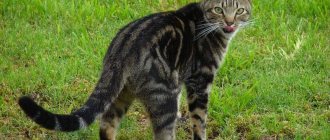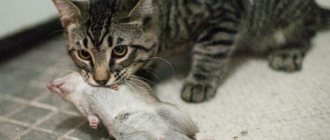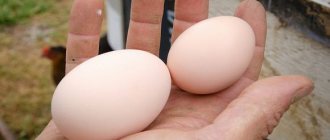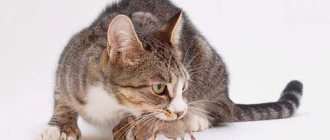Cats infected with toxoplasmosis often show no symptoms. In rare cases, cats develop lethargy, gastrointestinal problems, or even respiratory problems. Many cats will remain silent carriers their entire lives.
People can become infected with toxoplasmosis after handling cat litter containing the parasite and accidentally ingesting the microscopic cysts. They can also get it from eating contaminated meat.
Symptoms of toxoplasmosis in humans include fever, headache, lethargy and muscle pain. Toxoplasmosis may not actually cause any symptoms in people.
Warning: However, it can cause serious complications in pregnant women and people with weakened immune systems.
Intestinal parasites in cats
Many rodents are infected with common intestinal parasites such as roundworms. Intestinal parasites can cause diarrhea, vomiting and weight loss. Some intestinal parasites can be transmitted to other pets or people in the home.
If your cat goes outside or is known to have parasites, routine fecal testing for intestinal parasites is recommended. Your veterinarian may prescribe antiparasitic medications to deworm your cat. In addition, your cat will receive monthly heartworm and flea prevention with each dose.
Who is better at catching mice: a purebred or a yard cat?
Cats catch mice and rats for various reasons. Thus, some animals protect the territory in this way, take care of their offspring, or show their respect for the owner. Other representatives of the cat family, who have a well-developed hunting instinct, attack rodents for entertainment or to feed themselves.
Despite the fact that an animal's hunting instinct does not depend on its breed, there is an opinion that domestic pets are less interested in catching rodents than their domesticated relatives. There is some grain of truth in this statement. Street or stray cats catch mice for profit. Unfortunately, homeless animals often go hungry. They are forced to eat what they find or catch on the street. Pets, in turn, are considered more spoiled and sometimes even picky in their diet, so a mouse is not a valuable food item for them. In most cases, domestic cats hunt rodents for fun.
Video “How a cat hunts a mouse”
This video shows how a barn cat waits and catches its prey.
By gender
According to statements by felinologists, cats are considered the best mouse and rat catchers. The female is driven by maternal instinct. She goes hunting for two reasons. Firstly, the cat protects its offspring and eliminates all parasites nearby the house. Secondly, the female catches mice, rats, snakes, birds, moles and other representatives of the animal world in order to feed her offspring.
As for the cat, sometimes a pronounced sexual instinct does not allow the male to concentrate on hunting. The main task is to attract the attention of the female. For this reason, many breeders recommend that owners of country houses and private houses own rat-catcher cats.
Differences from sterilized individuals
Does the sterilization (castration) procedure affect the behavior and hunting instincts of domestic animals? Opinions on this matter are divided.
Sterilization (castration) is a surgical procedure as a result of which a cat cannot have offspring. It would seem that a decrease in testosterone should not affect the skills and habits inherent at the genetic level. However, in reality the situation is completely different: sterilized (neutered) pets become calmer, docile and imposing. Hunting, which requires mobility, concentration and attentiveness, is of little interest to them. Cats prefer a warm sofa and a ready-made bowl of food.
But there is also the opposite opinion. Some breeders claim that the sterilization (castration) procedure cannot affect nature. If hunting instincts are inherent at the genetic level, nothing can dull them.
Nutrition question
If you don't feed the cat, the feeling of hunger will make it catch the mouse. Logically, the statement is correct, but representatives of the cat family do not always catch rodents for profit. Mouse hunting is a kind of game.
Do cats eat caught prey? Of course, they especially like field mice, gerbils and shrews. But if the victim is a rat or a mole, the hunter is unlikely to eat his prey.
Another interesting fact from the life of representatives of the cat family: cats that are driven by hunger are less successful during the hunt, because they lack endurance and patience.
Plague bacteria in cats
Some rodents carry plague, an infection caused by the bacteria Yersinia pestis. 4 These are essentially the same bacteria that caused the infamous “Black Plague” of the Middle Ages. Plague is often spread by fleas, but cats can become infected by eating the meat of infected animals (often small mammals).
Cats infected with Yersinia pestis may experience lethargy, depression, loss of appetite, vomiting, diarrhea, cough, muscle soreness, and fever. The cat may develop swollen lymph nodes, lesions in the mouth, and weight loss.
Treatment includes the use of antibiotics and supportive care. The sooner treatment can be started, the higher the chances of survival.
People rarely become infected with the plague. When they do become infected, it is usually through a flea bite. Symptoms and treatment are relatively similar to those in cats.
How to let your cat know what is expected of him
If it is important for the owner for the cat to fulfill its direct natural purpose, it is worth trying to teach it to be a hunter.
Advice from experienced people contains different sequences of actions. The first ones recommend starting with developing a feeling of hunger. By keeping the animal on a “starvation diet” for some time, you can provoke it to go in search of food on its own.
Other experts recommend starting with developing the skills of agility, swiftness, attentiveness and tenacity. When a cat feels strong, she will become interested and want to show it in hunting. For training, you can use an artificial mouse, which you can quietly pull on a string, teasing and captivating the future hunter. You can pick up a live mouse that is not the first freshness, for example, the one that the neighbor’s cat caught.
According to others, the instinct to catch mice should be developed through stimulation. For each mouse caught, the animal should receive some kind of reward (a treat, a favorite pastime, a toy, etc.). Then he will have a natural interest in a process that promises new pleasures.
Finally, the fifth group of “cat experts” is of the opinion that the cat is an extremely intelligent animal. It always understands what is expected of it, but it doesn’t always want to do it. If you praise her, please her in every possible way, celebrate all her good deeds, but at the same time make it clear what is expected of her, she will definitely thank her for her kind attitude with caught living creatures.
Hantavirus infections
Several species of rodents are known to carry hantavirus. Cats can be infected with hantavirus but do not show any symptoms, so the virus is not harmful to them. Additionally, cats cannot transmit hantavirus to humans.
However, humans can be exposed through contact with infected rodents. 6 Although serious complications caused by hantavirus are uncommon in humans, exposure can lead to a serious illness called hantavirus pulmonary syndrome.
Appearance of the ratcatcher cat
The mousetrap cat has special external characteristics. The fur should be short and the whiskers long. Among the long-haired breeds, only a few are known to be excellent hunters. We are talking about the Norwegian forest breed and the Turkish Angora.
An important feature of a rat-catcher cat is the shape of the skull. If you press the animal's ears to the skull, the shape of the head becomes like a triangle. Large ears with tufts are another characteristic feature of a good rodent hunter.
It is equally important to pay attention to the color of the pet. The best mousetrap is a tri-colored female. Gray, red, black, spotted and striped fluffies also cope well with mice, rats and other rodents.
Toxicity of rodenticides
Rodenticide is very toxic to cats. 7 Cats can eat rat poison placed in and around the house. Most often, cats become infected after fully or partially eating a rodent that has ingested rat poison. There are several types of rat poison, so symptoms and treatment may vary. Exposure to rodenticides is very dangerous even in small quantities.
Rodenticides can cause symptoms such as lethargy, gastrointestinal upset, pale gums, drunkenness, seizures, and more. If you suspect your cat has been exposed to rat poison, contact your veterinarian immediately. Aggressive treatment is often necessary.
Maine Coon
These luxurious, large (weighing up to 15 kg) cats come from America, more precisely the state of Maine. They were specially bred to exterminate mice and rats on farms and ships. Despite their impressive size, Maine Coons are agile and agile. Large ears provide them with excellent hearing, and strong paws provide them with a good grip.
Thick, long hair allows the Maine Coon to live in harsh climates. But it also creates problems for the owners. The fact is that these cats need to be brushed regularly. If you leave the animal to its own devices, the magnificent fur will quickly become tangled and no longer protect against the cold.
The disadvantages of Maine Coons include gluttony (which should not be surprising, given their size) and independent character. These natural hunters are not particularly interested in constant human contact. They shy away from petting that they consider inappropriate, and if the owner is too intrusive, they can get angry and bite.
Ratcatcher cats need regular, long walks to stay in good physical shape.
Kurilian Bobtail
Bobtails are quite large animals, capable of rivaling Maine Coons in size. The weight of a cat can reach 10 kg, and that of a cat - 6 kg. The homeland of this breed is the Kuril Islands. Difficult living conditions raised them to be brave and strong hunters. They have a short tail and strong legs, providing excellent jumping ability. Bobtails cope with both mice and large rats.
Among other breeds, the bobtail is distinguished by its sociability and easy-going character. They readily make contact with humans, are easy to train and get along well with other animals, including large dogs. This makes them similar to another “tailless” cat - the Manx cat
, which also has a friendly disposition combined with excellent hunting skills.
Kurilian Bobtail
Manx cat
Relationship with the owner
A true Briton is smug and self-sufficient, and views his owners as breadwinners. It is not without reason that this breed is considered suitable for business people. They don't like to sit on their hands and can't stand noisy companies at all.
After a long day of work, the pet will greet the person reverently and tenderly, and will rub against the legs. They don’t like it when the owner stays late somewhere and doesn’t come home from work on time.
If there is a child in the family, you should not have a Briton for his entertainment. Representatives of this breed are very patient with children, but they will not allow themselves to be made into toys. They will hide and run away.
It is very rare for a straight-eared Briton to be “tame.” He doesn't often ask to be held and petted. However, when he needs to climb onto his owner’s lap, he will follow along until he achieves his goal.
The main signs of a rat catcher and a mouse catcher
The following signs can help you choose a kitten that will become your protector from rats, mice and other pests:
- Parents are hunters. Check with the owner of the cat family about this question. If the kitten’s parents hunt well, this skill will be passed on to their offspring by the age of four months;
- Gender of the kitten. As we said earlier, cats are more predisposed to hunting, and therefore it is advisable to give preference to them;
- Head shape. Cats with a triangular oriental skull shape are more predisposed to catching pests. You can determine the shape by pressing the ears to the animal’s head;
- Activity. Play with the kitten. If he actively plays and runs after strings and ribbons, hunting for them, it will be easier to raise him to be a thunderstorm of mice;
- Physiology. The cat should be well built, with developed muscles, powerful jaws and a strong body;
- Ears. It is believed that high ears topped with tassels are a sign of a hunter. They help the animal to better detect various rustles and squeaks;
- Color. As we have already said, the color of the coat should serve as a camouflage for the cat. The best colors are tricolor, variegated and tortoiseshell.
Parents-hunters teach kittens this skill from childhood.
It should be remembered that, just as you can make a hunter out of almost any cat, if you wish, you can make a lazy house cat out of any hunter. Much depends on the upbringing and living conditions of the animal.
How do cats hunt?
Cats have two hunting strategies: ambush and stalking. That is, either the cat, by smell, finds a hole or path on which prey may appear, and patiently waits for it, counting on a successful jump.
Or the cat tracks prey (most often by ear) and begins to sneak up on it. Sneaking, the cat slides in the grass, pressing its belly to the ground and using all natural shelters. Alternating between runs and stops, the cat approaches the prey within a jumping distance and stops. She moves her paws and twitches her tail to better time her jump. Then comes the final rush, when the cat jumps on the victim with its front paws and pins it to the ground to make it easier to deliver a fatal bite.
Cats bite their prey at the place where the skull meets the spine, breaking the animal's spine. If a cat is hungry, it will swallow small prey whole, and eat large prey gradually, starting from the stomach. This is what lions do in the savannah, eating buffalo or antelope. If the cat is not hungry, then it can play with half-dead or dead prey for a long time, sometimes the prey can even be saved during this game.
Cymric
These are medium-sized cats, also without a tail. They have long, tenacious legs that allow them to catch up with prey and grab it with a death grip. They have a strong skeleton with athletically developed muscles. Cymrics are sociable and active, and it is very important for them to spend a lot of time outdoors. It is not worth keeping such a mobile animal in an apartment - during games it will destroy everything around. Experienced breeders recommend keeping these cats in country houses.
Other breeds
As a hunter for a private home, you can purchase the following breed of cats:
- European Shorthair. Smart, active and inquisitive pets, distinguished by courage and bravery. The European Shorthair cat adapts to any weather conditions and is distinguished by its affectionate behavior. In the fight against rodents, animals have proven themselves to be ruthless killers.
- European tabby. The color of the animal is similar to that of a tiger. Tabbies are distinguished by their strong structure and muscularity, have a strong, large head, sharp teeth and claws. The hunting instinct is inherent from birth, so they grow up to be excellent mousecatchers.
- Turkish Angora. Cats of this breed have snow-white fur and blue eyes. Despite its defenseless appearance, the Turkish Angora tends to live in the yard and lead an active life. Thanks to fearlessness and curiosity, the pet effectively catches mice.
Character of Scottish Straight cats and cats
Scottish kittens are characterized by sedateness, independence and importance, at the same time they are active, inquisitive animals. They very quickly get used to a new place, among all the people living in the house
They immediately single out one person and unconditionally recognize him as a leader; a Scottish Straight cat will adore this person and follow on his heels. In the absence of people, he gets bored and always meets them at the doorstep, like a faithful dog.
With other family members, the Scots remain neutral and behave kindly; they are wary of strangers. They get along excellently with children, taking part in children's fun with pleasure. Kids, in turn, treat the charming teddy bears with delight and literally do not let go of the kitties.
However, parents should keep the situation under control, since straight-eared Scots cats cannot stand affection, squeezing, or being forced to be held in their arms, and when they break free, they can inadvertently scratch the child. They like much more to lie next to the owner, clinging to the person with their warm plush side. They rarely allow themselves to be petted and only when they want it.
Peace-loving, not at all touchy and unforgiving character, lack of aggressiveness make Scottish straight cats ideal companions for older people, and favorite pets for families with children (taking into account the points mentioned above about “cuddling”).
Straights easily find a common language with other animals living in the house: even with hamsters, even with dogs. They catch mice, and this “hunting” quality further increases the attractiveness of the breed.
Scottish Fold cats are not couch potatoes, unlike Persians, they are playful, but in moderation, they cannot be called too active, so you should not be afraid that in your absence they will cause disturbances in the house. They do not like heights and climbing curtains; exploring the wardrobes from above is not among their interests. Another thing is the inside of the closet, where a curious Scot will not hesitate to stick his charming nose.
Scottish Straight cats are not talkative; their meow can be heard extremely rarely, only if the animal is in pain or asks to be fed. More often they make peculiar sounds, reminiscent of creaking, or simply silently open their mouth.
Kittens quickly learn to use the toilet and scratching post. The last point is especially important, since straights have such a sin - they like to sharpen their claws on furniture or wallpaper.
Why do they bring mice to their owners?
No matter how funny it may sound, the first reason why cats bring caught mice to their owner is care and a desire to feed. Only then they call boasting, and the need to express gratitude for love.
A more scientific, but less popular option to explain why cats bring mice to their owners is thriftiness. The mousetrap cat brings the rodent home to save it “for later” and eat it when he gets hungry. Be that as it may, there is no point in punishing a successful hunter for such a “present”: be sure to praise the pet, take the gift and quietly throw it away.
Do your cats like to hunt? Do they bring you their prey?
Reasons for eating rodents
Why do cats catch mice, but either eat them completely out of hunger, or limit themselves to just the head of the rodent? The point is the chemical composition of the mouse brain and the taurine it contains. The cat's body is not able to synthesize it from other types of food.
In the absence of taurine, the cat will experience problems with the immune system, heart and eye diseases. The quality of wool also depends on the supply of taurine; mouse skin and the elements it contains play an important role in its condition. We can conclude: whether cats eat mice directly affects their health.
Tailed liberators of Leningrad
When all the cats in the besieged city were eaten in 1943, rats began to multiply at a catastrophic rate. They ran through the streets like a businessman in search of corpses, climbed into apartments, destroyed furniture and the last supplies.
The rodents were shot by special brigades and crushed by tanks, but the “rat troops” did not retreat. The city was saved by rat-catching cats of Russian and Siberian breeds. They were brought in trains from all over the country after the blockade was broken.
Today, two sculptures remind us of the four-legged liberators. One depicts the cat Vasilisa standing on the ledge, the second depicts the cat Elisha sitting opposite. St. Petersburg residents believe that whoever throws a coin on a cat pedestal will be lucky.
Behavior change
There are often cases when cats behave quite aggressively towards household members and guests. Pets are capable of not only scratching furniture, but also attacking. The animal experiences a kind of stress (usually due to dissatisfaction). This behavior goes from episodic to permanent status, since the pet considers it the norm.
The problem can be solved if the animal is sterilized in a timely manner. The cat becomes more accommodating as the source of “indignation” ceases to be relevant
If even several months after the operation the cat still continues to be mischievous, then the cause should be sought in other factors (constant stress, illness, lack of attention, etc.). In the first days after the operation, the animal may behave too calmly
It will seem that in such a short period of time the pet's activity will decrease significantly. But actually it is not. The rehabilitation period for each individual is different. For some, a couple of days are enough to recover, while for others it takes up to several weeks or even months.











